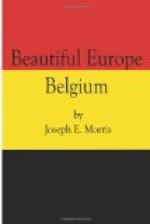It is not merely in its quality of unredeemed and absolute flatness that the great fen country of Flanders is so strongly reminiscent of the great fen country of the Holland parts of Lincolnshire. Each of these vast levels is equally distinguished by the splendour and conspicuousness of its ancient churches. Travelling by railway between Nieuport and Dixmude, you have on every side of you, if the day be clear, a prospect of innumerable towers and spires, just as you have if you travel by railway between Spalding and Sleaford, or between Spalding and King’s Lynn. The difference, perhaps, is that the Lincolnshire churches present finer architectural feature, and are built of stone, floated down in barges, by dyke or fen, from the famous inland quarries of Barnack, in Northamptonshire; whilst most of those in Flanders are built of local brick, though the drums of the piers and the arches are often of blue limestone. It is remarkable, certainly, that these soaring spires should thus chiefly rise to eminence in a setting of dead, flat plain. It may well be, indeed, as some have suggested, that the character of architecture is unconsciously determined by the type of surrounding scenery; that men do not build spires in the midst of mountains to compete with natural sublimity that they cannot hope to emulate, but are emboldened to express in stone and mortar their own heavenward aspirations in countries where Nature seems to express herself in less spiritual, or at any rate in less ambitious, mood.
As we cross the level prairie between these two little towns of West Flanders (we hope to visit them presently), a group of lofty roofs and towers is seen grandly towards the west, dominating the fenland with hardly less insistency than Boston “Stump,” in Lincolnshire, as seen across Wash and fen. This is the little town of Furnes, than which one can hardly imagine a quainter place in Belgium, or one more entirely fitted as a doorway by which to enter a new land. Coming straight from England by way of Calais and Dunkirk, the first sight of this ancient Flemish market-place, with its unbroken lines of old white-brick houses, many of which have crow-stepped gables; with the two great churches of St. Nicholas, with its huge square tower, and of St. Walburge, with its long ridge of lofty roof; and with its Hotel de Ville and Palais de Justice of about the dawn of the seventeenth century, is a revelation, in its atmosphere of sleepy evening quiet, to those who rub their eyes with wonder, and find it hard to credit that London, “with its unutterable, external hideousness,” was actually left behind them only that very morning, and is actually at present not two hundred miles distant. Furnes, in short, is an epitome, and I think a very charming one, of all that is most characteristic in Flanders; and not the less charming because here the strong currents of modern life that throb through Ghent and Antwerp extend only to its threshold in the faintest of dying ripples, and because you do not need to be told that in its town hall may still be seen hangings of old Spanish leather, and that the members of the Inquisition used to meet in the ante-chamber of the first floor of its Palais de Justice, in order to throw yourself back in memory to those old days of Lowland greatness from whose struggles Holland emerged victorious, but into which Belgium, for the time, sank back oppressed.




